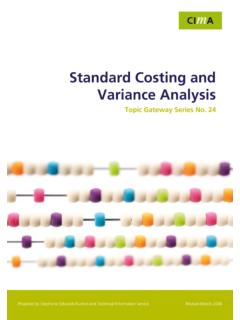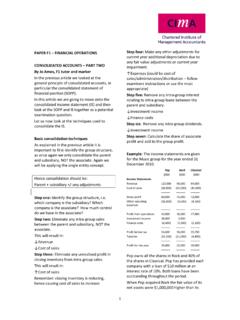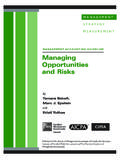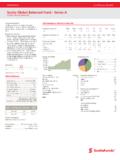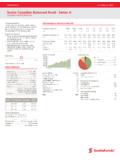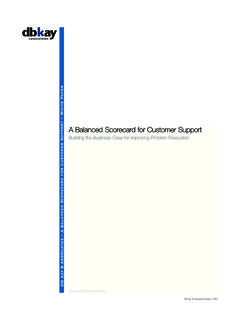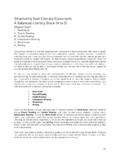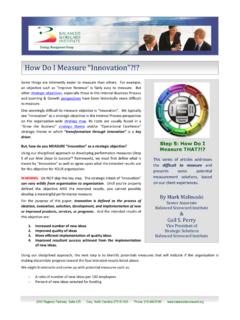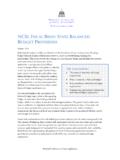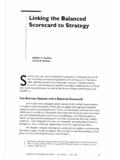Transcription of Effective Performance Management with the …
1 Effective Performance Management with the balanced ScorecardTechnical ReportWriters:Liz MurbyCIMAS tathis GouldCIMACIMA gratefully acknowledges the contributions ofGary Ashworth, Philip Barden, Peter Brewer, Gavin Lawrie, Bernard Marr,Professor Bob Scapens, Dr Mostafa Jazayeri-Dezfuli, and Francesco Copyright CIMA 2005 First published in 2005 by:The Chartered Institute of Management Accountants26 Chapter Street London SW1P 4NP Printed in Great BritainThe publishers of this document consider that it is a worthwhile contribution todiscussion, without necessarily sharing the views responsibility for loss occasioned to any person acting or refraining fromaction as a result of any material in this publication can be accepted by the authorsor the rights reserved. No part of this publication may be reproduced, stored in a retrievalsystem, or transmitted, in any form or by any means method or device, electronic(whether now or hereafter known or developed), mechanical, photocopying, recordedor otherwise, without the prior permission of the requests should be submitted to Performance Management1 Contents1.
2 Development of scorecard thinking.. From Performance measurement to strategic Management .. Strategy mapping.. An introduction .. Decision support.. Effective scorecard design.. 62. Implementation and practicalities.. Kaplan and Norton s five guiding principles .. Translate strategy into operational terms .. Align the organisation to the strategy .. Make strategy everyone s job .. Make strategy a continual process strategy Management meetings and the learning process.. 11 Mobilise change through executive leadership .. 143. Beyond Kaplan and Norton alternative complementary approaches.. Strategy mapping.. The value creation map .. The value dynamics framework .. Scorecard implementation .. The business modelling approach.
3 184. Dimensions of scorecard application.. The balanced scorecard in the public Embedding a sustainability focus with the balanced scorecard.. 195. Software in scorecard development and application.. 216. The balanced scorecard a resounding success?.. Why balanced scorecards sometimes fail .. Presentational/stylistic criticisms .. 267. Case studies.. Private sector: BAE Systems .. Public sector: Health Action Zone .. value dynamics framework at Dell .. Business Modelling Approach s if-then matrices .. Business Modelling Approach s implementation questionnaire .. 37 References and further information sources.. 38 This report focuses on one suchframework: the balanced the tools designed to improvecorporate Performance , the balancedscorecard has probably been the mostpopular.
4 Originally developed as aperformance measurement tool, thescorecard is now associatedincreasingly with strategyimplementation. It acts as amanagement framework with thepotential to identify and exploitorganisations key value drivers to theirbest strategic report considers the more recentdevelopments in scorecard thinking, inparticular the key role of strategymapping. It outlines how, through wideapplication, and facing ever-changingoperating conditions, the scorecard hasdeveloped over the last ten years, tosupport different organisational missions from profit maximisation,to service delivery or resourceoptimisation. For example, manyorganisations are realising increasinglythat much of their strategic value liesin their people, systems, processes andability to innovate this reportincludes an explanation of howorganisations can integrate thepotential of these intangibles in scorecard has been usedsuccessfully by organisations (public,private and not-for-profit) to realiseand integrate the strategic contributionof all relevant organisational valuedrivers for two key reasons:First, it helps to ensure consistencyand alignment between thenon-financial and the financialmeasures, (this helps to facilitate thealignment of the measures andstrategy).
5 Second, it helps to identify andmeasure the specific value drivers thatunderpin Performance . This allowsmanagers to test their hypotheses onwhat is driving report considers the use of thebalanced scorecard to link strategy toresources and then to performancemeasures, and offers guidance on thestrategy mapping process to ensurerobust cause-and-effect linkage. Newapproaches to bridging the gapbetween strategy and the balancedscorecard such as value-creationmapping and the value dynamicsframework are help organisations scorecard design,the report includes: Case-study based observations andpractical advice from twoorganisations that have implementeda balanced scorecard approach. Extensive references and signposts tofurther information and addition to the balanced scorecard,many organisations use a range oftools and techniques to improveperformance.
6 It is important tointegrate these with the scorecardapproach and we recommendtherefore that this report be read inconjunction with resources on othermanagement accounting techniquessuch as value-based Management ,activity-based costing, qualitymanagement and business processre-engineering. Recommended readingcan be found Performance Management2 IntroductionTo manage and deploy organisational resources in sucha way as to deliver and fulfil organisational objectives isa vital role of senior finance and managementprofessionals. Many tools, techniques and frameworkshave evolved to assist managers in this: value-basedmanagement, total quality Management , theperformance prism, and From Performance measurementto strategic managementThe balanced scorecard is amanagement framework which, sinceits inception by Kaplan and Norton inthe early 1990s, has been adopted,modified and applied by hundreds oforganisations worldwide.
7 If understoodthoroughly and implementedappropriately, its potential contributionto organisational success howevermeasured is scorecard translates vision andstrategy into four notional the original offering from Kaplanand Norton, these quadrants reflectedthe following perspectives andimplications of the strategy: Financial; Customer; Internal business processes; and Organisational learning and growth.(An overview of the balanced scorecardcan be found at: )The key to the popularity of thescorecard may lie in its flexibility andadaptability. Whether for commercialorganisations, governed by profits,public sector operations governed byservice delivery, or not-for-profitorganisations driven by commitmentto a particular cause, a scorecard thatimproves Performance (either throughperformance measurement, or viastrategy refinement)
8 , can first developed, the scorecardwas positioned as a holisticperformance-measurement framework,which could provide Management withuseful information relating to financialperformance, internal processes,customer perceptions and internallearning and opportunity to use suchinformation to satisfy the concerns ofnot only internal Management but alsoexternal stakeholders was soonacknowledged, and companies such asSears, Citicorp, and AT&T, as well asnumerous public sector organisationsdeveloped such stakeholderscorecards . By first identifying theinterested parties whose objectivesthey sought to satisfy, (shareholders,customers, employees, suppliers etc),the organisations then defined goalsfor each and developed stakeholdercards of appropriately balancedstakeholder-related measures andtargets, in an attempt to meet theneeds of second-generation scorecardsallow individuals and teams to definewhat they must do well to contributeto higher-level goals.
9 They are foundmost frequently in manufacturing andhealthcare organisations, especiallythose that have been implementingtotal quality Management programmes(TQM, Malcolm Baldridge awardinitiatives), which generate manymeasures to monitor processes andprogress. Such stakeholder scorecards,were criticised by some, as being littlemore than an extended list of keyperformance indicators (KPIs).As organisations developed their ownscorecards to measure Performance ,each generated valuable information,relating to many aspects oforganisational analysis of this information,added to organisational knowledge ofoperations and their impacts, madepeople aware of the potential of theframework from a performancemanagement perspective rather thanone of Performance underlying premise of the strategicscorecard is straightforward: that allthe actions determined bymanagement decisions andimplemented to promote strategyrealisation, have an impact.
10 Tosuccessfully contribute to achievementof an organisation s mission, thescorecard must effectively interpretstrategy into operational is thus operationalised through the assumed relationshipsbetween actions and their impacts. Bymeasuring these impacts (via thescorecard s identified key performanceindicators), Management information which informs decision-making , by introducing thisconcept of causality into scorecarddesign, more recent refinements tobalanced scorecard use have exploitedits potential value as a framework forstrategic Management . Through theuse of strategic objectives , manyorganisations, both private and public,have used the scorecard to placestrategy, rather than financial metrics(simple budgets, economic valueadded, shareholder return etc.) at theheart of their Management objectives, first representedas short sentences attached to each ofthe four perspectives, can be used tohighlight the essence of theorganisation s strategy relevant toeach.


